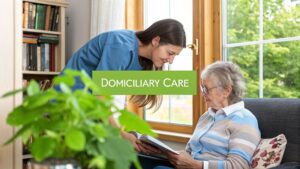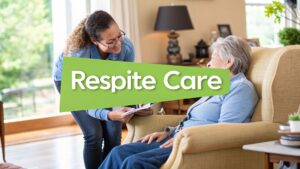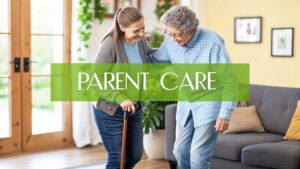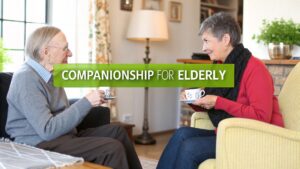Preventing falls is about taking practical, proactive steps to keep older adults safe, confident, and independent. It’s not about wrapping them in cotton wool or limiting their life; it’s about making smart adjustments to their home and routine that empower them to live fully and safely.
Why Fall Prevention is a Crucial Part of Ageing Well
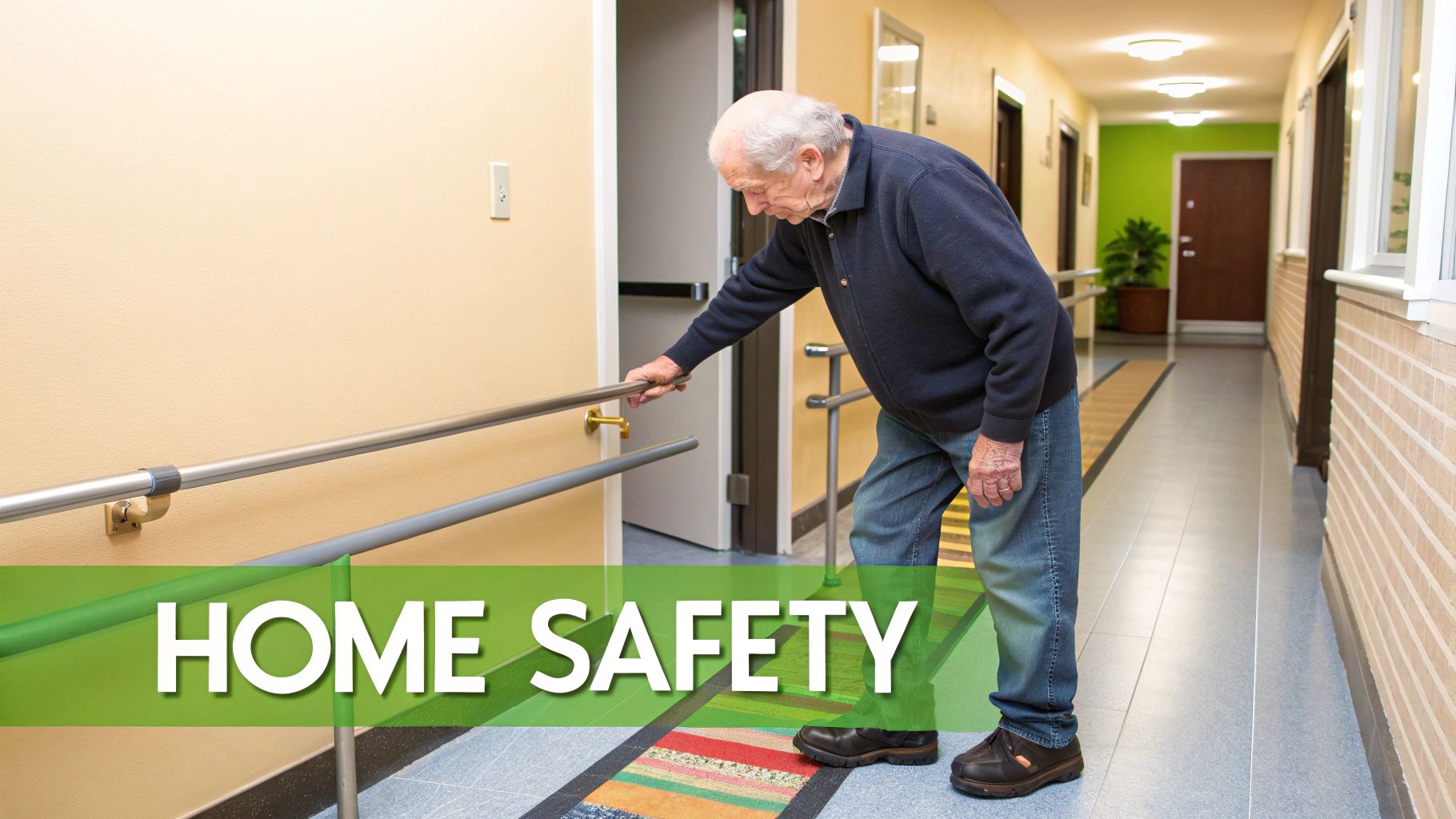
Let's be honest, the thought of a fall can be genuinely frightening for older adults and their families. This fear can sometimes become so overwhelming that it stops someone from doing the things they love, like going for a walk or visiting friends. The key is to shift the focus from fear to proactive organisation.
The truth is, falls aren't just an inevitable part of getting older. More often than not, they happen because of a mix of factors that we can absolutely identify and manage. By taking a clear-eyed look at the risks, we can build a safer environment and boost the physical resilience needed to stay steady on your feet.
The True Impact of Falls in the UK
The numbers really bring home why this is such a critical issue here in the UK. About one in three people over 65 will have at least one fall a year. That figure jumps to a staggering 50% for those aged 80 and over. To put that into perspective, in 2022/23 alone, falls resulted in around 210,000 emergency hospital admissions in England for that age group. For more detail, you can always look at the latest NICE guidelines on fall prevention.
But the impact goes far beyond the physical injury. A fall can completely shatter a person's confidence, creating a vicious cycle. They become afraid to move, which leads to weaker muscles and poorer balance, which, in turn, makes another fall even more likely.
"Preventing a fall is about much more than avoiding an injury. It's about preserving independence, maintaining social connections, and ensuring that life can be lived to its fullest, without fear or limitation."
Common Causes That Increase Fall Risk
To prevent falls effectively, you need to know what you’re up against. It's rarely one single thing, but more of a 'perfect storm' of different factors coming together. A solid prevention plan looks at the whole person and their environment.
Here are some of the most common culprits I see in my experience:
- Hidden Home Hazards: It’s the simple things that often catch people out. Dimly lit hallways, a rug that isn't secured, a bit of clutter on the stairs, or no grab rails in the bathroom are all classic trip hazards.
- Medication Side Effects: Certain medications can cause dizziness, drowsiness, or a sudden drop in blood pressure, all of which can throw someone off balance. Common ones include some blood pressure tablets, sedatives, and antidepressants.
- Underlying Health Conditions: Things like low blood pressure (hypotension), arthritis making joints stiff, poor eyesight, or problems with the inner ear can all seriously affect a person's stability.
- Muscle Weakness and Poor Balance: As we age, we naturally lose some muscle mass and our balance isn't as sharp. If someone isn't very active, this decline happens much faster, making it harder to recover from a simple trip or stumble.
Getting to grips with these specific risks is the first, most important step. By tackling each of these areas, we can dramatically reduce the chances of a fall and help older adults continue to lead the active, fulfilling lives they deserve.
Making Your Home a Safer Space to Live
Your home is your sanctuary, the one place you should feel completely safe and comfortable. But for many older adults, the familiar surroundings can hide unexpected dangers. The reality is that many falls happen at home, often caused by hazards we’ve walked past a thousand times and no longer even notice.
The good news? You don't need a massive budget or a full-scale renovation to make a real difference. It’s all about looking at your space with fresh eyes and making small, sensible changes. This isn’t about limiting independence; it’s about enabling it for years to come. Think of it as future-proofing your home so you can continue to live confidently and actively.
How to Start Your Home Safety Audit
The most effective way to begin is by doing a thorough, room-by-room walkthrough. It’s a great idea to ask a friend or family member to join you—a second pair of eyes will almost always spot things you’ve grown accustomed to. The aim is simple: find anything that could cause a trip, slip, or loss of balance.
Start with the most-used areas of the house. Are the main pathways clear? Think about the route from the living room to the kitchen, or from the bedroom to the loo in the middle of the night. Clutter is a major enemy here. That pile of magazines you've been meaning to read, a trailing phone charger cable, or even a decorative rug can become a serious hazard.
A safe home environment is the foundation of fall prevention. Simple modifications can remove the most common hazards, giving you greater freedom of movement and real peace of mind.
Staying physically active is just as important as modifying your home. Activities like Tai Chi are brilliant for improving balance and strength, which work hand-in-hand with a safer living space.
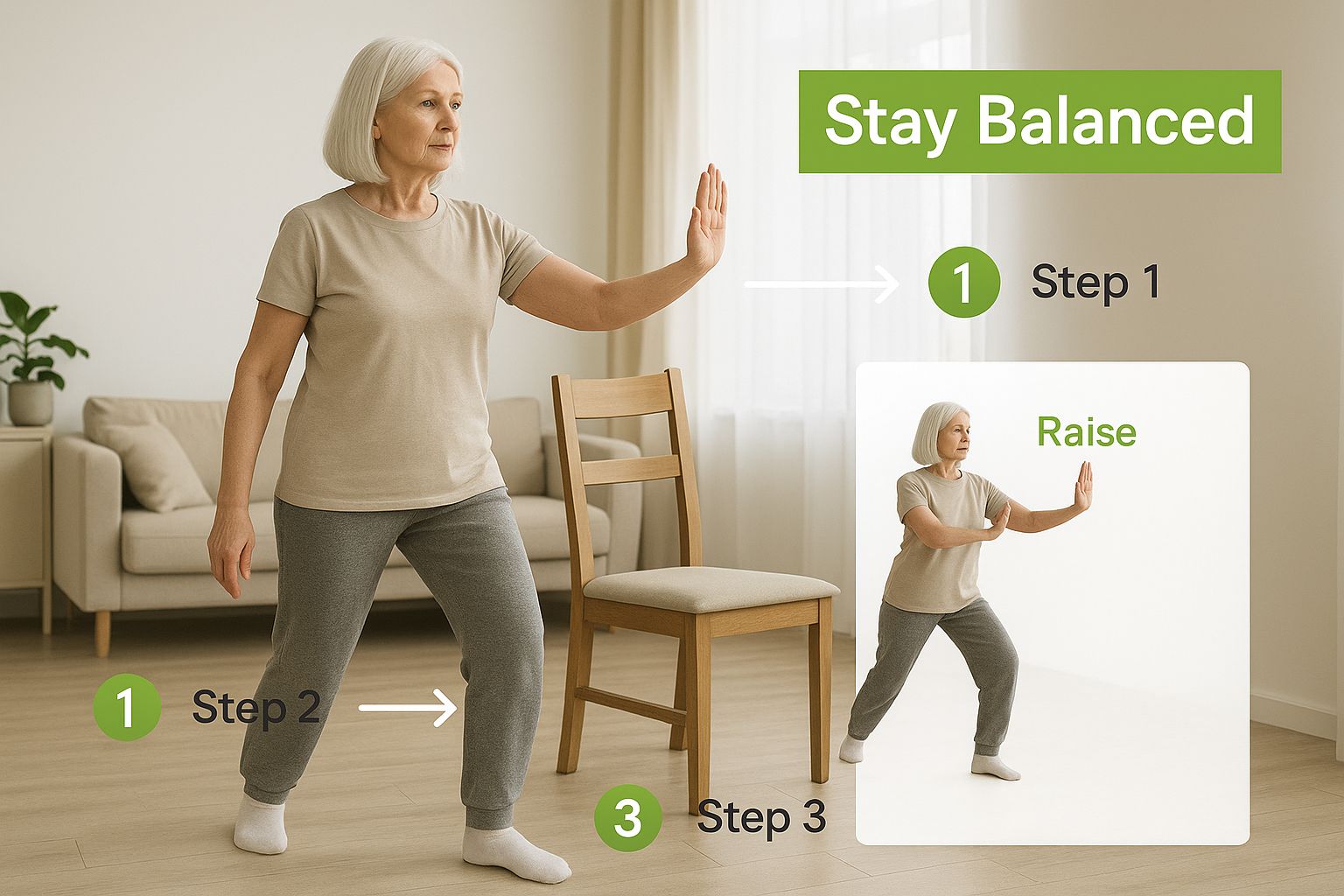
This image is a great reminder that a safe home and an active body are two sides of the same coin when it comes to preventing falls.
Key Hotspots to Tackle First
Some parts of the home are just riskier than others. By focusing on these areas first, you can get the biggest safety boost for your efforts.
-
Floors and Rugs: Loose rugs are notorious for causing trips. The easiest fix is to get rid of them altogether. If you love your rugs, make sure they’re secured with double-sided tape or a non-slip backing. Have a quick look over your carpets, too, checking for any worn or frayed edges that could catch a toe.
-
Lighting: It’s amazing what poor lighting can hide. Walk through your home in the evening to find any gloomy corners or dark spots. It might be as simple as swapping to higher-wattage bulbs in hallways, on stairs, and at entrances. Pop a few nightlights in the bedroom, hallway, and bathroom—they're a cheap and cheerful way to make those night-time trips much safer.
-
Stairs: Stairs are a big one and need careful attention. Make sure they are well-lit from top to bottom, ideally with light switches at both ends. Handrails should feel completely solid, be fixed securely, and run the entire length of the staircase. If you can, having them on both sides is even better. If you have a carpet runner, give it a tug to ensure it’s firmly fastened down.
Making the Bathroom Safer
With its mix of water and hard surfaces, the bathroom is a prime spot for slips and falls. Thankfully, there are some very effective and straightforward fixes.
A non-slip mat inside the bath or shower is a must-have, along with an absorbent bath mat for the floor. But perhaps the most important change you can make is installing grab rails. Be strategic about where they go—one to help get in and out of the bath or shower, and another next to the toilet, can make a world of difference.
A raised toilet seat can also be a huge help, as it reduces the strain of sitting down and getting back up. And make sure shampoo, soap, and other toiletries are within easy reach to avoid any risky stretching or bending. For some, having a carer on hand provides that extra layer of security, and it's worth exploring how personalised home care supports independent living to create a truly supportive environment.
Room-by-Room Home Safety Checklist
To help get you started, I've put together a simple checklist to guide you through your home safety audit. Use it to spot potential issues and keep track of the fixes you want to make.
| Area of Home | Key Hazard to Check | Simple Solution |
|---|---|---|
| Living Room | Trailing electrical cords and wires | Secure cords along walls or use cable tidies to keep them out of walkways. |
| Kitchen | Spills and wet floors | Clean up spills immediately. Use non-slip floor polish or mats near the sink. |
| Bedroom | Clutter around the bed or on the floor | Keep a clear path from the bed to the door. Use a bedside table for essentials. |
| Hallways | Dim lighting | Install brighter bulbs and consider adding nightlights for visibility after dark. |
| Bathroom | Slippery surfaces in the bath/shower | Use a non-slip rubber mat inside the shower and install sturdy grab rails. |
| Staircases | Worn-out carpet or lack of handrails | Ensure handrails are secure on both sides and repair or replace any worn treads. |
This checklist covers the basics, but remember to look for anything specific to your own home and routine.
How to Talk About Making Changes
Bringing up home modifications with a parent or loved one can be tricky. It's easy for them to feel like you're suggesting they can no longer cope. The key is to frame the conversation with care and positivity.
Explain that these changes aren't about taking away independence—they're about empowerment. These are simply tools to help them keep living safely in the home they love. Focus on the universal benefits: a brighter hallway is better for everyone, and a grab rail is just a sensible safety feature, no different from a seatbelt in a car. By tackling this as a practical project together, you can help turn their home back into a true sanctuary.
Building Stability with Strength and Balance Exercises
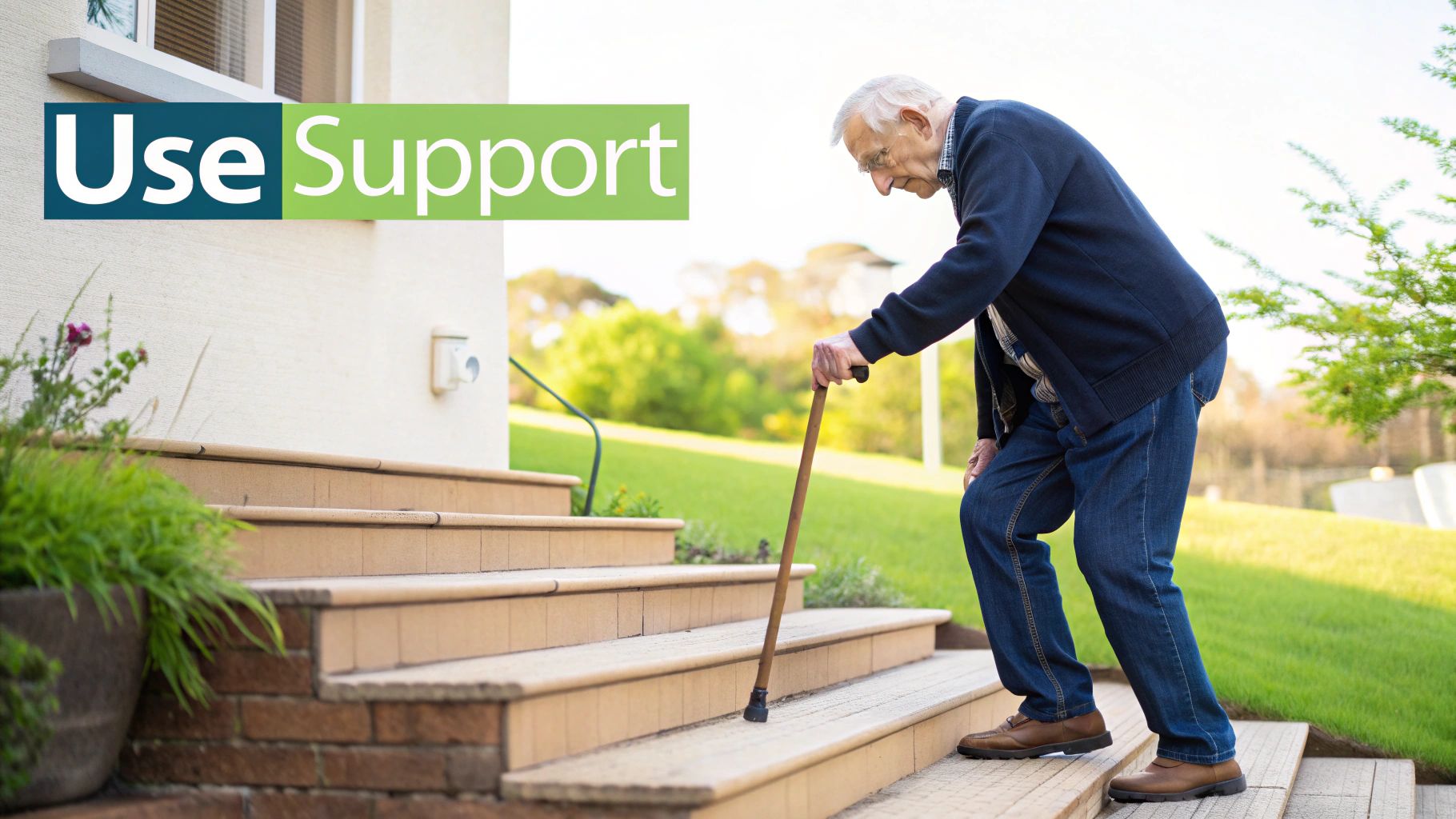
While making your home safer is a crucial first step, building up your physical resilience is perhaps the most powerful tool you have for preventing falls. When your muscles are stronger and your balance is sharper, you can react more quickly to a stumble, steady yourself, and simply move with more confidence.
The best part? You don't need a fancy gym membership or complicated equipment. Simple, focused movements, done consistently, can make an enormous difference. This is all about weaving movement into your daily routine in a way that feels achievable and empowering, not like an intimidating chore.
Simple Exercises to Do Safely at Home
The most effective exercises for fall prevention are the ones that strengthen the key muscles in your legs and core while training your body to stay balanced. When you're just starting, it's always a good idea to have a sturdy chair or a kitchen counter nearby for a bit of support.
Here are a few simple but incredibly effective movements you can try:
- Chair-Based Leg Lifts: Sit up straight in a solid chair, with your feet flat on the floor. Slowly extend one leg out in front of you, hold for a moment, and then lower it back down with control. Aim for 10-15 repetitions on each side. This is fantastic for your quadriceps—the big muscles on the front of your thighs that you use every time you stand up.
- Sit-to-Stand: From that same seated position, cross your arms over your chest and practise standing all the way up and sitting back down slowly. The trick is to do it without using your hands for a push-off. This is one of the best functional exercises out there because it directly mimics an action we do countless times a day.
- Tandem Walking: For this balance-booster, stand with one hand resting on a wall for support. Place the heel of one foot directly in front of the toes of the other, like you're walking a tightrope. Hold that position for a few seconds before taking the next "step." It's a safe, controlled way to challenge your balance.
Remember, consistency trumps intensity every time. A little bit of movement each day will do you far more good than one long, exhausting session once a week.
A common misconception after a wobble is that it's safer to be less active. In my experience, the opposite is true. Gentle, targeted exercise is the best way to rebuild the strength and confidence that a fear of falling can so easily take away.
The Proven Benefits of Structured Programmes
While home exercises are a great foundation, joining a structured programme in your community can add expert guidance and a welcome social element. In the UK, two of the most respected options are Tai Chi and the Falls Management Exercise (FaME) programme.
Tai Chi, often called "meditation in motion," uses slow, flowing movements that are brilliant for improving balance, flexibility, and leg strength. Because it’s so low-impact, it's suitable for almost anyone, no matter their current fitness level.
For something more targeted, evidence-based programmes like FaME have shown fantastic results. This is a progressive, 24-week regimen that’s personalised to your needs. It focuses not just on strength and balance but also on practical skills like reactive stepping and how to get up safely from the floor.
Regaining Confidence Is Half the Battle
A fall—or even just the fear of one—can really knock your confidence. It can make you hesitant to move, which often leads to a downward spiral of weaker muscles and, ironically, an even higher risk of falling. Exercise is the key to breaking that cycle.
Every time you complete a set of leg lifts or hold your balance for an extra second, you’re not just strengthening a muscle; you're sending a powerful message to your brain: "I am capable. I am in control." This gradual rebuilding of self-trust is just as vital as the physical work.
Incorporating these activities can also be a key part of a wider care plan. While some people may need a hand with daily tasks, it's vital to distinguish between different kinds of support. Understanding the difference between personal care and home help ensures that any support you receive is enabling, always focusing on maintaining independence and physical activity where possible.
Ultimately, making strength and balance work part of your life is an investment in your own future. It’s a proactive choice to stay independent, active, and connected to the world, standing steady on your own two feet.
The Power of a Proactive Health Check
Preventing falls is about so much more than just clearing clutter from the floor. It means taking a good, honest look at your overall health. Think of it as a personal health MOT—a chance to work with your GP and other healthcare professionals to spot and manage any underlying issues that might be quietly putting you off balance.
This is about seeing the bigger picture. A fall is rarely caused by just one thing; it's often a perfect storm of factors. This could be anything from a medical condition or medication side effect to poor eyesight or mobility problems. In fact, research from UK hospitals shows that assessing and tackling these multiple risk factors together can slash the rate of falls by a staggering 20% to 30%. You can see the details of these multifactorial assessment findings on PMC.
Your Medication Cabinet Review
One of the most practical things you can do is book a medication review. It's surprising how many common prescriptions—and even some over-the-counter remedies—can cause side effects like dizziness, drowsiness, or a sudden dip in blood pressure. All of these are major culprits when it comes to falls.
It’s not just about a single pill, but how different medications might be interacting. A quick chat with your GP or local pharmacist can help you get ahead of any potential problems before they lead to a slip or trip.
Don't hesitate to ask specific questions. A simple, "Could any of my tablets be making me feel unsteady?" can start a vital conversation. Sometimes, all it takes is a small tweak to your dosage or changing the time you take a pill to make a world of difference.
Keeping Your Senses Sharp
Your eyes and feet are your body's personal navigation system, constantly sending information to your brain to keep you stable. It's easy to overlook them, but keeping them in top condition is a cornerstone of any good fall prevention plan.
Regular eye tests are absolutely essential. As we get older, conditions like cataracts or glaucoma can sneak up on us, subtly affecting our depth perception and ability to spot hazards. Making sure your prescription is current is one of the simplest, most effective steps you can take.
Foot care is just as crucial. If your feet hurt because of corns, bunions, or just badly fitting shoes, you'll naturally change the way you walk, which can easily throw your balance off. A routine check-up with a podiatrist will keep your feet healthy, comfortable, and ready to provide a solid foundation for every step you take.
A proactive health check is your best defence. By regularly reviewing your medications, vision, and underlying health conditions with your GP, you transform fall prevention from a guessing game into a personalised, effective strategy.
Addressing Underlying Health Conditions
Sometimes, the real reason for unsteadiness is an undiagnosed medical condition or one that isn't being managed as well as it could be. Several common health issues can have a direct impact on your balance and stability.
- Orthostatic Hypotension: Ever feel dizzy when you stand up too quickly? That's what this is—a sudden drop in blood pressure. Your GP can easily check for it and suggest simple ways to manage it.
- Vitamin D Deficiency: This vitamin is vital for strong bones and muscles. A lack of it is incredibly common here in the UK, especially in the winter months. A simple blood test can tell you if your levels are low.
- Inner Ear Problems: Your inner ear is the command centre for your balance. Conditions like vertigo can cause severe dizziness and really need a specialist to get them sorted.
Knowing about these potential causes puts you in a much stronger position when you talk to your doctor. For those who might need a bit of extra help at home while getting these conditions under control, understanding how to arrange care can be a huge relief. Our guide to home care services in 5 simple steps explains the process clearly.
By taking a comprehensive approach to your health, you're building a robust defence against falls and empowering yourself to stay independent and confident.
Using Technology and Aids for Extra Support
The right tools can make a huge difference in staying safe on your feet, giving both practical support and priceless peace of mind to everyone in the family. Thinking about assistive aids isn't about giving up; it’s about being smart and proactive to hold onto your independence. From a simple walking frame to a modern personal alarm, these bits of kit can be the very thing that helps you feel confident, not vulnerable.
When you embrace these aids, you’re giving yourself an extra layer of protection, making it possible to keep living the life you want, safely. It means that if a stumble does happen, help is never far away. That reassurance alone is often just as vital as the physical support the devices give.
Choosing the Right Walking Aids
Walking aids are one of the first things people turn to for better stability, but picking the right one is absolutely crucial. A walking stick that’s too tall or a frame that’s too clunky can easily cause more problems than it solves. You’re looking for something that feels like a natural extension of your body—offering support without tripping you up.
This is where a professional assessment comes in. An occupational therapist or a physiotherapist is the best person to look at your specific gait, strength, and balance to recommend the most suitable aid. They’ll also make sure it’s fitted perfectly to you and show you how to use it properly, which is a massive part of preventing falls.
"An assistive device should enable, not hinder. The right aid, properly fitted, provides the stability needed to walk with confidence, turning a potential hazard into a manageable activity."
Getting a Professional Assessment
So, how do you get this expert advice? In the UK, the best starting point is your local council. You can ask for a free home needs assessment through their adult social services department. Typically, an occupational therapist will pop round to see what daily life looks like for you and recommend specific aids, equipment, or small changes to your home.
For smaller bits of kit like walking frames, grab rails, or bath seats, the council may even provide them free of charge after an assessment. This professional input takes all the guesswork out of the process, ensuring you get support that’s genuinely tailored to you.
Personal Alarms and Modern Telecare
Beyond mobility aids, today’s technology offers a fantastic safety net. Personal alarm systems, which you can wear as a pendant or a wristband, give you a direct line to a monitoring centre 24/7. Just press a button, and a trained operator will speak to you, figure out what’s happening, and call family, neighbours, or the emergency services if needed.
Many of these systems are now clever enough to include automatic fall detection. They use sophisticated sensors to recognise if you’ve had a heavy fall and will automatically send an alert, even if you’re unconscious or can’t reach the button. It’s a brilliant piece of technology that gets help on the way fast, which is critical for a better recovery after a fall.
To help you get a sense of what might work best, here’s a quick comparison of the most common aids.
Comparing Common Assistive Devices for Mobility
Choosing the right device can feel overwhelming, but understanding the basics makes it much easier. Each type of aid is designed for a different level of support, from a bit of extra balance to full-on stability. This table breaks down the main options to help you and your family start the conversation about what's most appropriate.
| Device Type | Best For | Key Considerations |
|---|---|---|
| Walking Stick | Providing minor support and improving balance for those who are generally steady on their feet. | Must be the correct height—the handle should be level with your wrist bone when your arm is relaxed at your side. |
| Walking Frame | Offering significant stability for individuals who need much more support than a stick can provide. | Can be cumbersome in tight spaces and needs to be lifted over obstacles like doorsteps or rugs. |
| Rollator (Wheeled Frame) | Supporting those who need stability but also have the strength to manage a wheeled device. Often has a handy seat. | The brakes must be in good working order and used correctly, especially before you attempt to sit down on the seat. |
| Personal Alarm | Anyone living alone who wants the reassurance that help can be summoned quickly in an emergency. | It only works if you wear it! Remember to check for any monthly monitoring fees when comparing providers. |
Ultimately, choosing to use technology and aids is about taking control. By finding the right tools for the job, you’re adding a powerful layer to your fall prevention plan, giving you the confidence to navigate your world more safely.
Your Questions on Fall Prevention Answered
It’s completely normal for families to have a lot of questions when it comes to preventing falls. The sheer amount of information can feel a bit daunting, and it's often hard to know where to start. We get it. Here, we've answered some of the most common queries we hear from families, offering straightforward advice to help you take the next steps with confidence.
What Should I Do After a Loved One Falls?
The first thing to do is to take a breath and stay calm. Check on them and see if they are obviously hurt before you even think about moving them. If they've hit their head, are unconscious, or seem to be in a lot of pain, call 999 immediately. Don't hesitate.
If they feel they're able to get up, your job is to help them do it slowly and safely. Guide them towards a sturdy piece of furniture, like a dining chair, to use for support. Even if they insist they're perfectly fine afterwards, it’s absolutely crucial to book a visit with their GP. A fall can be the first sign of an underlying health problem that needs a proper look.
How Can I Suggest Changes Without Causing Offence?
This is a tricky one, and it requires a gentle touch. The best approach is to frame the conversation around making life easier and safer so they can maintain their independence, not about what they can or can't do.
Try using "we" language. For example, you could say, "I was thinking, what can we do to make the hallway a bit brighter?" or "Let's look at getting a non-slip mat for the shower." It shifts the focus from their limitations to a shared goal of smart, forward-thinking planning. It's about teamwork, not a critique of their abilities.
Are Falls Just a Normal Part of Getting Older?
No, absolutely not. This is probably the biggest and most damaging myth out there. While it's true that the risk of falling increases with age, falls are not an inevitable part of ageing.
The vast majority of falls are preventable. By taking proactive steps—like targeted exercise, home safety modifications, and regular health checks—you can significantly reduce the risk and maintain your mobility and confidence for many years to come.
Where Can We Get Financial Help for Home Modifications?
In the UK, a great place to start is your local council. The first step is to ask their adult social services department for a free home needs assessment. This usually involves an occupational therapist visiting to assess the home and recommend specific, practical changes.
For larger, more expensive adaptations like a stairlift or a walk-in shower, you might be eligible for a Disabled Facilities Grant (DFG). For smaller aids and minor changes that cost under £1,000, the council may even provide these for free, depending on what the assessment finds.
Taking this route ensures the modifications are perfectly suited to your loved one’s needs. For family members doing the supporting, remember to look after yourselves too. We have a guide that explains why respite care is crucial for family caregiver wellbeing, which is full of tips for avoiding burnout while ensuring your loved one gets the best care.
At Cream Home Care, we provide personalised support that helps older adults live safely and independently in the comfort of their own homes. To learn how our compassionate care services can assist you or your loved one, visit us at https://creamhomecare.co.uk.

